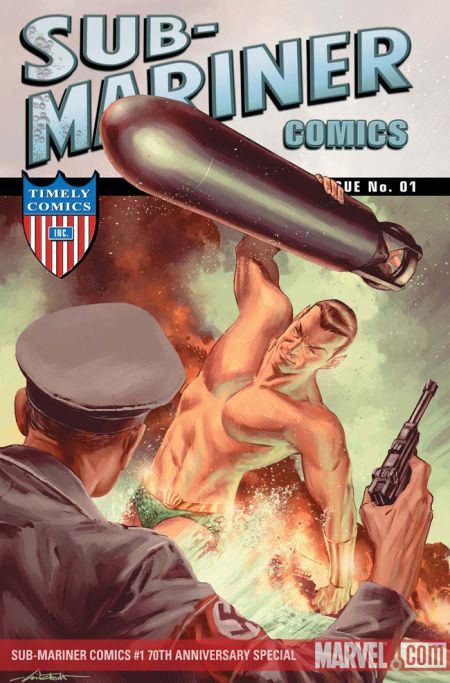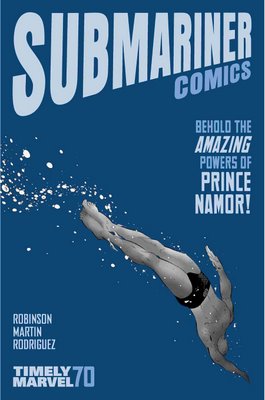- Comics
- Comics Reviews
- Manga
- Comics Reviews
- European Comics
- News
- Comics News
- Press Releases
- Columns
- Spotlight
- Digital Comics
- Webcomics
- Cult Favorite
- Back Issues
- Webcomics
- Movies
- Toys
- Store
- More
- About
By Andy Frisk
April 15, 2009 - 21:28
Marvel’s 70 Anniversary specials continue with a look at Namor, The Sub-Mariner with three tales: two new ones and a reprint of Namor’s appearance in Marvel Comics #1, from October 1939.
In this three story volume, we get a tale by Roy Thomas about Namor’s involvement in the pre-American involvement World War II year of 1939. He is protecting British and American ships from German U-Boat attacks, convinced by Betty Dean that this is necessary, and agreed to by Namor because his father was American. In the second tale “Sub-Mariner: Vergeltungswaffe!” also taking place during the pre American involvement World War II year of 1939, Namor is the complete anti-surface world, arrogant non-interventionist. He’s more interested in letting the surface world nations destroy one another, and keeping their weapons out of the seas. In the final tale, reprinted from Marvel Comics #1, written and published, not just set, in 1939, Namor is the young unintentional murderer of underwater, human divers, and ready devourer of his mother’s hate for the surface dwellers.

These three tales all relate events from the early days of Namor’s activity and interaction with the surface dwelling humans. In the tale from 1939, Namor is the willing absorber of his mother’s hate mongering. In the 2nd tale he is a questioning thinker, if not too deeply, of the surface female pilot Jenny Keaton’s noble actions toward him in setting him free from Nazi captors, and trusting him to help her even though he’s “an unknown creature of alien species.” He is beginning to understand that surface dwellers are more complicated than he thought, i.e. not all are evil creatures. In the volume’s first tale by Roy Thomas, Namor is a willing participant against the Nazis, but is now questioning whether or not even they, as his enemies, are not his “kinsmen” as well, and considers abandoning his efforts, and leaving the fate of the surface world to itself. All of these tales relate interesting takes on Namor and his varying views on his race, his place in the two worlds he is descended from, because of his mixed race, and his involvement with the men and women of the two worlds.
In the oldest tale Namor’s mother is the picture of bile spilling hate towards the surface dwellers for their, it appears, unwitting destruction of her undersea kingdom. Namor, suggested to be around 19 years old, swallows his mother’s story hook, line and sinker (a dangerous thing for a “fish-man” to do!), although he does question why the surface people are all so bad, since his father was one. In Thomas’ tale though, taking place nearly a year later, if we accept the fact that Marvel Comics #1’s publication date of October 1939 is the date of the story’s events as well, Namor meets a true hate mongering Nazi female spy, who attempts to seduce him to the Nazi cause, which he rejects violently after allowing her to reveal to him the location of her U-Boat, and crew off the waters of New York City and her message of racist hate. It appears that Namor has grown, and matured greatly over the course of this one year, coming to understand the nature of his mother’s, and his own once arrogant, racial bigotry. He now realizes that the hate espoused by the Nazi spy and his mother, while different in motivation is destructive, and has no validity. It is interesting that Namor’s moral and ethical maturation is spurred on by the women in his life at the moments of these tales; first by his mother who leads him along, then by Jenny Keaton who stirs the questioning of his mother’s hate, instilled in him, then by Betty Dean who enlists his help for a just cause, and finally Ursula, the Nazi spy who fixes his moral compass, and directs his outbursts of violence in the right direction through her example of evi,l which clears Namor’s questions about whether he should battle the Nazi’s or not.

All of these interesting dichotomies set up in these tales form an interesting dialogue. Namor is a man born of mixed race, and battles within himself over how much to embrace his “inferior” surface dweller side, and whether it really is “inferior” or not, learning the error of this thinking. All of this “battling” is metaphoric of real life racial issues which we as a nation, and species have overcome to a certain extent, even though racism in all its ugly forms do still exist to the detriment of mankind. Namor is a man who is influenced either rightly, or wrongly, by the women in his life to varying degrees which are beneficial and detrimental. His male ego and pride keep him from seeing clearly, at least at first, the error in the evil women’s rhetoric, and the validity in the righteous arguments of the women on the side of the angels. The use of his mother’s influence over him to essentially brain wash him, and his continued defective distrust of women after this event speaks metaphorically to real life gender politics and conflicts. Namor also being a creature who can survive in air and in water, two mutually exclusive elements that share similar atomic structures, is a metaphor itself for just how insignificant the distinction between two different elements, races or species are, and how they can destroy each other over such insignificant differences, or unite to celebrate those differences to the benefit of all. These dichotomies are presented but not really resolved within the structure of these tales, but certain "solutions" are pointed to. The important thing about these tales is that these important questions are raised for discussion in a comic book, with a relatively “silly” lead character nonetheless.
I never really considered or was a fan, per se, of Namor. I always though of him as a little silly, a “fish-man” with bird wings on his feet, but I overlooked his metaphoric significance, and am glad that I picked up this volume. It helped explain the significance of this character’s complexity, and storytelling potential. It would be interesting to see how other writers over the years have used Namor, and how writers in the future will. There’s a lot to write about considering his complexities.
Rating: 9 /10